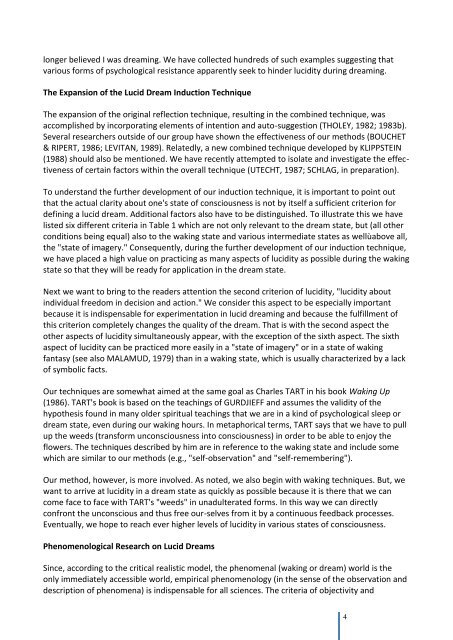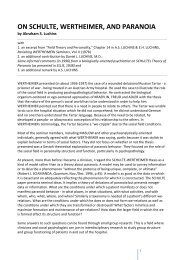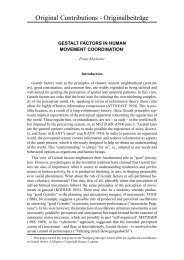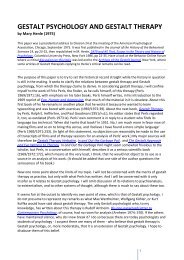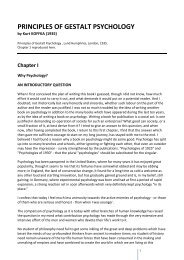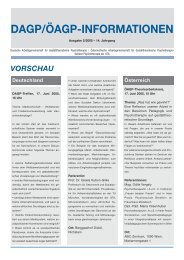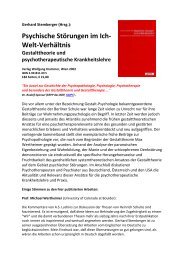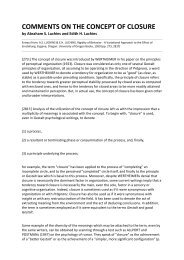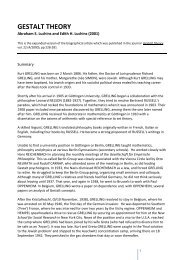pdf-Download - Society for Gestalt Theory and its Applications (GTA)
pdf-Download - Society for Gestalt Theory and its Applications (GTA)
pdf-Download - Society for Gestalt Theory and its Applications (GTA)
Create successful ePaper yourself
Turn your PDF publications into a flip-book with our unique Google optimized e-Paper software.
longer believed I was dreaming. We have collected hundreds of such examples suggesting thatvarious <strong>for</strong>ms of psychological resistance apparently seek to hinder lucidity during dreaming.The Expansion of the Lucid Dream Induction TechniqueThe expansion of the original reflection technique, resulting in the combined technique, wasaccomplished by incorporating elements of intention <strong>and</strong> auto-suggestion (THOLEY, 1982; 1983b).Several researchers outside of our group have shown the effectiveness of our methods (BOUCHET& RIPERT, 1986; LEVITAN, 1989). Relatedly, a new combined technique developed by KLIPPSTEIN(1988) should also be mentioned. We have recently attempted to isolate <strong>and</strong> investigate the effectivenessof certain factors within the overall technique (UTECHT, 1987; SCHLAG, in preparation).To underst<strong>and</strong> the further development of our induction technique, it is important to point outthat the actual clarity about one's state of consciousness is not by <strong>its</strong>elf a sufficient criterion <strong>for</strong>defining a lucid dream. Additional factors also have to be distinguished. To illustrate this we havelisted six different criteria in Table 1 which are not only relevant to the dream state, but (all otherconditions being equal) also to the waking state <strong>and</strong> various intermediate states as wellùabove all,the "state of imagery." Consequently, during the further development of our induction technique,we have placed a high value on practicing as many aspects of lucidity as possible during the wakingstate so that they will be ready <strong>for</strong> application in the dream state.Next we want to bring to the readers attention the second criterion of lucidity, "lucidity aboutindividual freedom in decision <strong>and</strong> action." We consider this aspect to be especially importantbecause it is indispensable <strong>for</strong> experimentation in lucid dreaming <strong>and</strong> because the fulfillment ofthis criterion completely changes the quality of the dream. That is with the second aspect theother aspects of lucidity simultaneously appear, with the exception of the sixth aspect. The sixthaspect of lucidity can be practiced more easily in a "state of imagery" or in a state of wakingfantasy (see also MALAMUD, 1979) than in a waking state, which is usually characterized by a lackof symbolic facts.Our techniques are somewhat aimed at the same goal as Charles TART in his book Waking Up(1986). TART's book is based on the teachings of GURDJIEFF <strong>and</strong> assumes the validity of thehypothesis found in many older spiritual teachings that we are in a kind of psychological sleep ordream state, even during our waking hours. In metaphorical terms, TART says that we have to pullup the weeds (trans<strong>for</strong>m unconsciousness into consciousness) in order to be able to enjoy theflowers. The techniques described by him are in reference to the waking state <strong>and</strong> include somewhich are similar to our methods (e.g., "self-observation" <strong>and</strong> "self-remembering").Our method, however, is more involved. As noted, we also begin with waking techniques. But, wewant to arrive at lucidity in a dream state as quickly as possible because it is there that we cancome face to face with TART's "weeds" in unadulterated <strong>for</strong>ms. In this way we can directlyconfront the unconscious <strong>and</strong> thus free our-selves from it by a continuous feedback processes.Eventually, we hope to reach ever higher levels of lucidity in various states of consciousness.Phenomenological Research on Lucid DreamsSince, according to the critical realistic model, the phenomenal (waking or dream) world is theonly immediately accessible world, empirical phenomenology (in the sense of the observation <strong>and</strong>description of phenomena) is indispensable <strong>for</strong> all sciences. The criteria of objectivity <strong>and</strong>4


